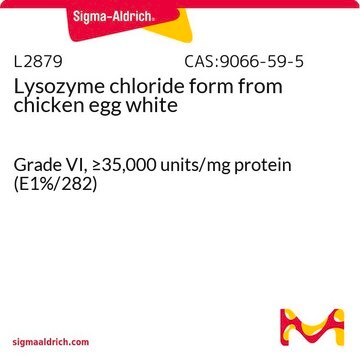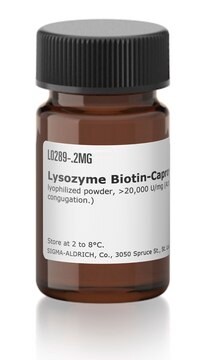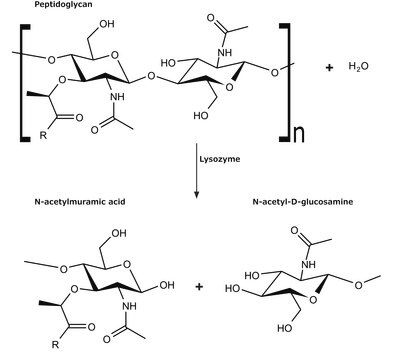10837059001
Roche
Lysozyme
from hen egg white
Sinonimo/i:
Mucopeptide N-acetylmuramoyl-hydrolase, Muramidase, lysozyme
Autenticatiper visualizzare i prezzi riservati alla tua organizzazione & contrattuali
About This Item
Prodotti consigliati
Origine biologica
chicken egg white
Livello qualitativo
Saggio
≥95%
Forma fisica
solid
Attività specifica
>23000 U/mg (Shugar units)
PM
14.4 kDa
Confezionamento
pkg of 10 g
Produttore/marchio commerciale
Roche
pH ottimale
6.0-7.0
Assorbimento
3.9 at 280 nm (10 mg enzyme/ml)
Descrizione generale
Muramidase, Mucopeptide N-acetylmuramoyl-hydrolase
Applicazioni
Lysozyme has been used for:
- Cell wall degradation
- Preparation of protoplasts
- Bacteriolysis
- Pharmacology (anti-inflammatory effect on mucous membrane; healing of tissue; protection against bleeding; normalization of mucus secretion; dissolution of pyrogens; potentiation of antibiotics)
- Food and drinks (flavor enhancer)
- Sample preparation prior to isolation of nucleic acids
Lysozyme has been used in the monitoring of transcription by real-time -PCR and sample preparation.
Azioni biochim/fisiol
Lysozyme hydrolytically cleaves the bonds between N-acetyl-D-glucosamine and N-acetylmuramic acid residues (GlcNAc β1-4Mur) in mucopolysaccharides and the glycan skeletons of the corresponding peptidoglycans (the latter are glycosaminoglycans linked to or crosslinked by peptide chains). Lysozyme effectively destroys the cell walls of bacteria.
Definizione di unità
One Shugar unit is that quantity of enzyme in 1 ml of a suspension of Micrococcus luteus of pH 7.0 whose initial absorbance at a wavelength of 450 nm is 0.750 for a pathlength of 10 mm which causes the absorbance to decrease at the rate of 0.001 per minute, all measurements being carried out at a temperature of +25 °C.
Nota sulla preparazione
Working solution: Lysozyme hydrochloride is readily soluble in water and buffer solutions but insoluble in organic solvents.
Storage conditions (working solution): -15 to -25 °C
Aqueous solutions of the hydrochloride (2 mg/ml dist. water) can be stored for several days at 2 to 8° C or at -15 to -25° C for several weeks.
Storage conditions (working solution): -15 to -25 °C
Aqueous solutions of the hydrochloride (2 mg/ml dist. water) can be stored for several days at 2 to 8° C or at -15 to -25° C for several weeks.
Ricostituzione
Prepare a stock solution at a concentration of 50 mg/ml in dist. water. Dispense into aliquots and store at -15 to -25 °C. Discard each aliquot after use.
Stoccaggio e stabilità
Store at 2 to 8 °C. (Store dry!)
Altre note
For life science research only. Not for use in diagnostic procedures.
Codice della classe di stoccaggio
11 - Combustible Solids
Classe di pericolosità dell'acqua (WGK)
WGK 2
Punto d’infiammabilità (°F)
does not flash
Punto d’infiammabilità (°C)
does not flash
Certificati d'analisi (COA)
Cerca il Certificati d'analisi (COA) digitando il numero di lotto/batch corrispondente. I numeri di lotto o di batch sono stampati sull'etichetta dei prodotti dopo la parola ‘Lotto’ o ‘Batch’.
Possiedi già questo prodotto?
I documenti relativi ai prodotti acquistati recentemente sono disponibili nell’Archivio dei documenti.
I clienti hanno visto anche
A new iron acquisition system in Bacteroidetes.
Manfredi P, et al.
Infection and Immunity (2014)
Visualization of RNA 3? ends in Escherichia coli Using 3? RACE Combined with Primer Extension
Xun Wang, et al.
Bio-protocol, 8(5) (2018)
Kimberly M Davis et al.
Infection and immunity, 79(2), 562-570 (2010-11-03)
Bacterial pathogens that colonize mucosal surfaces have acquired resistance to antimicrobials that are abundant at these sites. One of the main antimicrobials present on mucosal surfaces is lysozyme, a muramidase that hydrolyzes the peptidoglycan backbone of bacteria. Cleavage of the
Yuriy Rebets et al.
Methods in molecular biology (Clifton, N.J.), 1539, 99-144 (2016-12-03)
The choice of an expression system for the metagenomic DNA of interest is of vital importance for the detection of any particular gene or gene cluster. Most of the screens to date have used the gram-negative bacterium Escherichia coli as
Blanca López-Méndez et al.
European biophysics journal : EBJ, 50(3-4), 411-427 (2021-04-22)
Microscale thermophoresis (MST), and the closely related Temperature Related Intensity Change (TRIC), are synonyms for a recently developed measurement technique in the field of biophysics to quantify biomolecular interactions, using the (capillary-based) NanoTemper Monolith and (multiwell plate-based) Dianthus instruments. Although
Il team dei nostri ricercatori vanta grande esperienza in tutte le aree della ricerca quali Life Science, scienza dei materiali, sintesi chimica, cromatografia, discipline analitiche, ecc..
Contatta l'Assistenza Tecnica.






